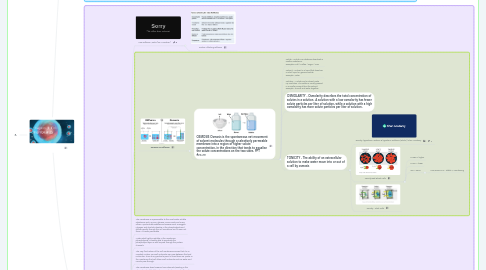
1. 3.
2. 1. Inside the Cell Membrane
2.1. DIFFUSION is less efficient in cells with a small SA of membrane relative to their VOLUME of cytoplasm.
2.1.1. As cell size INCREASES the SA:VOL decreases = less efficient p21-23
2.2. Raw Egg - Shell
2.2.1. 6:1
2.2.1.1. 2:1
2.3. 1.a. Phospholipid
2.3.1. HYDROPHILIC = attracted to water HYDROPHOBIC = repelled by water
2.3.1.1. FLUID MOSIAC MODEL - gives the membrane flexibilty
2.3.1.1.1. The Plasma Membrane
2.3.2. Makes the PHOSPHOLIPID BILAYER that makes up membrane. It is FLUID - keeps moving.
2.3.2.1. 'BI' means two
2.3.3. Parts of Cell Membrane (1)
2.3.3.1. PROTEINS have important roles
2.3.3.1.1. Peripheral Proteins sit on outside
2.3.3.1.2. Integral proteins sit within bilayer (PROTEIN CHANNELS)
2.3.3.1.3. BOTH types of proteins can have carbohydrate attached - called GLYCOPROTEIN OR if attached to LIPID becomes GLYCOLIPID
2.3.3.2. CHOLESTEROL
2.3.3.2.1. Lipid - stabilises membrane and maintains fluidity.
2.3.3.2.2. Animals - called CHOLESTEROL
2.3.3.2.3. Plants - called PHYTOSTEROL
2.4. Parts of Cell Membrane (2)
2.5. 1.b. The cell membrane is a selectively or semi permeable barrier controlling the movement of substances into and out of the cell.
2.6. 1.c. Some substances (e.g. water) can diffuse very easily through the membrane, while larger proteins need to be actively assisted to travel through specialised transport proteins.
2.7. 1.d. FUNCTIONS PPT #9
2.7.1. > control movement of substances into and out of the cell
2.7.2. > help in active transport of materials across it
2.7.3. > help maintain the cell shape
2.7.4. > provide a certain degree of mechanical support to the cell
2.7.5. > maintain each cell as an integral structure.
2.7.5.1. > act as a receptor for extracellular material and thus maintain the integrity of each type of cell
3. 2. MOVEMENT THROUGH THE MEMBRANE PPT #11
3.1. How Diffusion Works [HD Animation]
3.1.1. Factors Affecting Diffusion
3.2. Osmosis Vs Diffusion
3.2.1. OSMOSIS Osmosis is the spontaneous net movement of solvent molecules through a selectively permeable membrane into a region of higher solute concentration, in the direction that tends to equalise the solute concentrations on the two sides. PPT #26-30
3.2.1.1. Solute: A solute is a substance dissolved in another substance. Examples: Salt / Coffee / Sugar / Urea
3.2.1.2. Solvent: A solvent is a liquid that dissolves a solid, liquid or gaseous solute. Example: Water
3.2.1.3. Solution: A solute and a solvent make up a solution. The solute is usually present in a smaller amount than the solvent. Example: The salt and water together.
3.2.1.4. OSMOLARITY - Osmolarity describes the total concentration of solutes in a solution. A solution with a low osmolarity has fewer solute particles per liter of solution, while a solution with a high osmolarity has more solute particles per liter of solution.
3.2.1.5. TONICITY - The ability of an extracellular solution to make water move into or out of a cell by osmosis
3.2.1.5.1. Tonicity: hypertonic, isotonic & hypotonic solutions (article) | Khan Academy
3.2.1.5.2. Tonicity Red Blood Cells
3.2.1.5.3. Tonicity - Plant Cells
3.3. The membrane is impermeable to the usual water soluble substances such as ions, glucose, amino acids and many others. Lipid-soluble substances however such as oxygen, nitrogen and alcohols dissolve in the phospholipids and diffuse rapidly through the cell membrane as if it were not there. It is semi-permeable
3.4. Water whist highly insoluble in the membrane phospholipids, is readily able to penetrate the phospholipid layer as well as pass through the protein channels.
3.5. The very fluid nature of the cell membrane ensures that it is in constant motion, so small molecules can pass between the lipid molecules. Thus at any particular point in time there are ‘pores’ in the membrane that will allow small molecules such as water and urea to pass through.
3.6. The membrane does however have channels (existing in the integral protein) that these larger molecules can enter through.
3.7. Passive Vs Active
3.7.1. Active
3.7.2. Cell Transport PPT #16-26
3.7.3. PASSIVE = NO energy required
3.7.3.1. Simple Diffusion
3.7.3.1.1. Moves with the flow means it moves with the concentration gradient
3.7.3.2. Protein Channels - PROTEINS are helping or facilitating the movement
3.7.3.2.1. Facilitated Diffusion
3.7.3.2.2. Charged Ions H+, Na+ and glucose use the transport PROTEINS
3.7.4. ACTIVE = ATP energy is required. Made of 3 phosphates. When BOND is broken in last phosphate a HUGE amount of ATP energy is released. p16-17
3.7.4.1. Goes AGAINST the concentration e.g. glucose from the in the cell of gut lining as compared to environment
3.7.4.1.1. From LOW to HIGH
3.7.4.2. ATP energises the protein channel to allow for movement in opposite direction
3.7.4.3. MOVEMENT OF LARGE MOLECULES p17-19 PPT#60-66
3.7.4.3.1. Endocytosis - 'endo' means 'in'
3.7.4.3.2. Phagocytosis - The transport of solid particles into a cell inside a vesicle – a special form of endocytosis.
3.7.4.3.3. Exocytosis - The transport of solid particles into a cell inside a vesicle – a special form of endocytosis.
3.7.5. The Semipermeable Membrane
